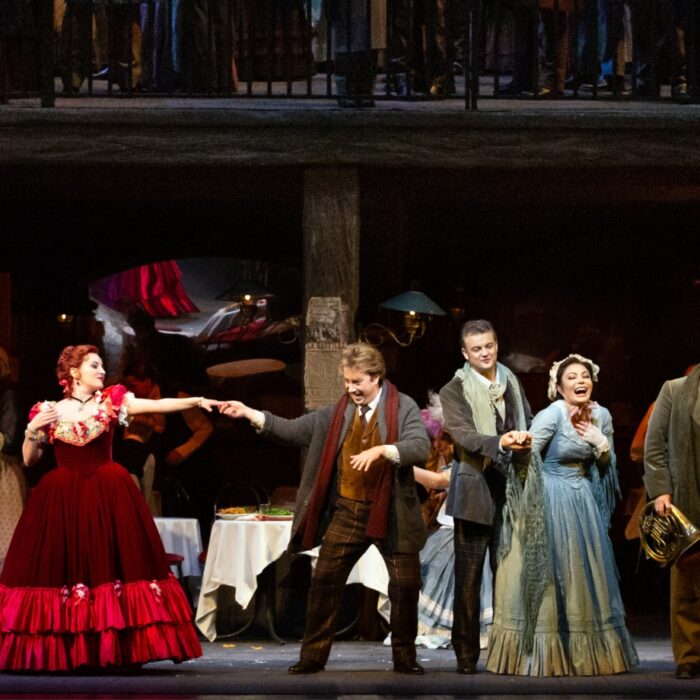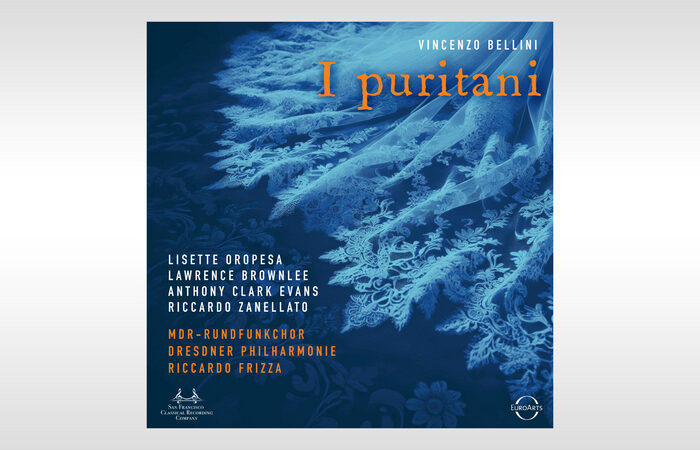
Opera Las Vegas 2023 Review: Behold the Man
Composer Paul Fowler and Librettist Andrew Flack Delight Audience Members of All Ages with Their Modern Comic Opera
By Jennifer PyronPhoto credit: © Richard Brusky
“Behold the Man” made its world premiere at the Nicholas J. Horn Theatre for Opera Las Vegas’ 25th season on September 30th and October 1st, 2023. What began as a curious and fun project between creative team members, composer Paul Fowler, librettist Andrew Flack and producer Barbara Duff, has now evolved into something beyond their wildest dreams – a successful modern comic opera with extraordinary insight about what makes social media a “social benefit.”
The Real Story Behind the Painting
The “Ecce Homo” (Behold the Man) fresco, by Spanish artist Elías García Martínez, was originally painted on the wall of the Sanctuary of Mercy church in Borja, Spain circa 1930. At that time, it was considered to be nothing remarkable. Traditionally it supported the typical Catholic art style. Artistically, however, Martínez’s work was underappreciated by critics for not supporting interests of innovation and modernity. Basically, the fresco was just another painting, on another wall, of another Catholic church, and in another Spanish Catholic town.
Over time the small town, where the fresco resided, started experiencing increasing despair in their economy and in 2012 they became desperate to do something, anything, in order to “save” their livelihood.
Cue the “call from God!”
This is when a local, devout Catholic, Cecilia Giménez, started having dreams. She explained to her sister, Beatriz, how God had visited her in a dream and inspired her to restore the town’s “Ecce Homo.” The church would then have a good reason to invite outsiders to visit and revel in its revival. However, Beatriz was skeptical about this idea due to Cecilia’s lack of artistic experience with portraits and the fact that she was approaching 81-years-old, with less than ideal eyesight. Cecilia specialized in murals and restoring a historical work of art under a lot of pressure could prove to be too much. But, Cecilia pressed on. She told the church’s priest about her devotion to restoring in “good faith.” She was determined to make this miracle happen – and for free.
The restoration stemmed from her deep faith and spiritual guidance. Once she started painting, she also felt divine inspiration from artist Elías García Martínez who she felt was guiding her.
Unfortunately, the finished product did not go over well. In fact, it was disastrous. Cecilia was shamed among her fellow townspeople. Even media reports commented on how this was the worst restoration in modern history.
But again, Cecilia pressed on.
At this point, social media started absorbing the story. Over the coming days, weeks, months and years it morphed into a phenomenon. It was fascinating how far the story traveled and how fast, but the most important part about “how” this happened is “why.” These were the early days of social media. Like, back when memes, gifs, and funny blips were just being created. And this is a good thing because people were celebrating Cecilia’s disaster in a positive way. “Ecce Homo” became a series of memes, gifs, and a lot of press coverage describing the fresco as the “Monkey Christ.” Kate McKinnon even did a skit as Cecilia on SNL!
There was also an increasing buzz around Borja. People traveled from all over, and still do, to get a coveted selfie with the “Ecce Mono” (Behold the Monkey). An unusual amount of attraction and compassion was stirring and this is when composer Paul Fowler and librettist Andrew Flack knew they had to make it into something more.
Again, cue the “call from God!”
Where There’s a Will, There’s a Way
“Behold the Man” is an engaging opera. It outlines the ever-developing story of Borja’s near fall and eventual rise to fame with a rare combination of excitement and forgiveness. Along with an easy-to-follow synopsis, Cecilia Giménez is a relatable lead character and her heart of gold makes for an interesting character development that supports a comic opera’s happy ending. What often happens in new operatic works is the temptation to overemphasize a story in order to prove a point instead of letting it be more open to interpretation. This is where “Behold the Man” excels. It does not push. In fact, what Paul Fowler and Andrew Flack emphasize the most is the innocent simplicity of humanity – the essence of human will.
In addition to focusing on a good story, Fowler and Flack chose Opera Las Vegas for their world premiere. This is also a very good thing. Vegas itself is a small city full of lights and entertainment that knows how to capture its audiences. General director Jim Sohre welcomed the audience and described how delighted he was to feature “Behold the Man” as its 25th season opener. Audience members were all smiles as he spoke because he could not stop smiling. There was definitely something special in the air. Music director and principal conductor Joshua Horsch led the members of Las Vegas’ Philharmonic, chorus and youth chorus. His energy and attention to Paul Fowler’s musical references were spot on from the start.
Mezzo-soprano Kimberly Gratland James as Cecilia was the perfect match. From her very first note and through her last, one might say she channeled the voice of Cecilia. The beating heart on fire to save her own town and make right what most thought was done wrong, this was how James’ voice sounded. The audience clearly understood her, too, which in opera makes a huge positive difference. Her voice’s middle range mirrored her natural speaking voice and so this also made for a great vocal choice for a comic opera.
Mezzo-soprano Ashley Stone as Beatriz accompanied James’ Cecilia very well. Their voices were like kindred spirits singing together. Stone’s greatest vocal strength is her empathetic response to the material she is performing and to the cast members she is performing with. She brought warmth and grace to the opera stage.
The opera’s synopsis intelligently followed the story of Cecilia, but what made this opera shine is how it imaginatively played up the ghost of artist Elías García Martínez and the “Ecce Homo” fresco. The audience was in love with baritone André Chiang as he let loose what one might describe as the “spirit of God” through his characters. Chiang delighted in the honesty of comedy and transparency of telling a good story at the same time. Every time he was on stage, or on screen as the virtual version of “Ecce Homo,” the audience was in tears laughing and commenting among one another. For me personally, I have never been to an opera where I felt the joy and excitement buzzing around me in this way. It was like a live wire generating a feel good buzz the entire time. Audience members also applauded between every scene of the opera. They congratulated the performers in this way, but what stuck out to me most was a feeling of anticipation for what would happen in the next scene. And let me just say, laughter was definitely in the cards.
What Would Jesus Do?
Jesus would make a great meme.
In fact, the history of gifs and memes is interesting. Do you remember the first time you saw one? Or, even better, do you remember the first time someone sent you one? If so, what was it?
It’s true, social media has the ability to generate good humor through shared emotional responses to nuanced context like “Ecce Mono.” Even if someone has no idea where the context originated from, the bandwidth that it can travel is infinite. And most importantly, “church giggles” are the best!
In “Behold the Man” the idea of Jesus as a gif and meme gets transformed into a visual tapestry of hilariousness. Literally the panels at the back of the stage, where one can read subtitles, transition into a live action visual of the singing “Monkey Christ.” Baritone André Chiang sings as the botched “Ecce Homo” fresco and runs with it. The audience could not get enough of this scene. It’s also important to note that while visuals are common in operas nowadays, to experience them in this way is something brand new.
Gifs and memes create solidarity. Audience members of all ages can have something to laugh about and feel included when watching a screen play gifs and memes, especially the surprise factor of a live action one! Bravo to projection designer Catherine M. Pratt, producer Barbara Duff, and the entire creative team for making light of social media as a “good thing.” This is very rare, indeed.
More Stellar Cast Highlights
Bass-baritone Tyler Putnam as Cura Viejo made light of his authoritative role. His natural sense of humor shone bright and his quick witted timing was spot on. Tenor Collin Salmon made his official Opera Las Vegas company debut as the town’s mayor, Alcalde. His voice was a presence of sound reason and judgement that had a heart for his beloved small town. Tenor William McCullough as Cecilia’s son, Marcos, made an excellent companion to soprano Olivia Yokers as his wife, Adriana. McCullough’s voice was gentle and pure. Yokers’ performance was dynamic and well-thought-out. She knew when to be over the top, but that wasn’t her only skill. Yokers’ English diction was very distinct. Her crisp text made it enjoyable to follow along when she was having her “Affluenza” melt-down.
The young lovers, Silvia and Arturo, were performed by soprano Athena Mertes and baritone Marshall Morrow. This duo seemed inseparably in sync. The audience enjoyed their characters and could relate most when watching their dramas unfold. Vocally, they sounded relatable as well. Which brings up another point: opera is meant to be a shared experience and comic opera is meant to uplift anyone from any background, especially if one has never seen an opera before.
The character development all throughout “Behold the Man” felt honest and transparent. Basically, what you see is what you get. It was also a magical highlight when the children’s chorus took stage! All of them gathered around the virtual “Ecce Homo” to get their selfie and to do their celebratory dance. One might imagine Cecilia on stage dancing too!
“Saving” the Best for Last
Composer Paul Fowler is a modern musical mastermind. “Behold the Man” is a refreshing take on a traditional style that stays on course the whole time. There are moments of blurred imaginings reminiscent of Bach, Mozart, Bel Canto, pop, Zarzuela, 50’s lounge music, tango, flamenco, Purcell… to satisfy every listener’s palette of choice.
Librettist Andrew Flack combined with Paul Fowler is a divine match. These two come from the heart in all they do and it is felt in every moment along the way. “Behold the Man” deserves to continue its party! This new opera is meant to be shared and heard by everyone, everywhere. Whether in its English or Spanish version, Cecilia Giménez’s story is a timeless tale.



